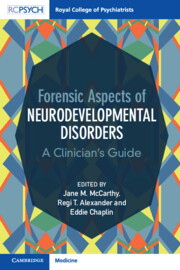Book contents
- Forensic Aspects of Neurodevelopmental Disorders
- Forensic Aspects of Neurodevelopmental Disorders
- Copyright page
- About the Cover Page
- Contents
- Contributors
- Foreword by the Rt Hon Lord Bradley
- Terminology Used in the Book
- Section 1 An Overview: Definitions, Epidemiology and Policy Issues
- Section 2 Assessment and Therapeutic Approach
- Section 3 Criminal Justice Pathways and Legal Issues
- Chapter 16 Criminal Justice Pathways and Neurodevelopmental Disorders
- Chapter 17 The Mental Health Act and Other Relevant Legislation in Relation to Neurodevelopmental Disorders in the UK
- Chapter 18 Fitness to Plead and Neurodevelopmental Disorders
- Chapter 19 Fitness to Plead Procedures in Relation to Mental Health and Capacity Legislation
- Chapter 20 Forensic Services for Neurodevelopmental Disorders: An English Perspective
- Chapter 21 Offenders with Neurodevelopmental Disorders in Four Nordic Countries
- Chapter 22 Forensic Neurodevelopmental Disabilities: A Perspective from Ontario, Canada on Pathways and Services
- Chapter 23 Forensic Aspects of Neurodevelopmental Disorders: An Australasian Perspective
- Chapter 24 Concluding Comments
- Index
- References
Chapter 21 - Offenders with Neurodevelopmental Disorders in Four Nordic Countries
from Section 3 - Criminal Justice Pathways and Legal Issues
Published online by Cambridge University Press: 18 May 2023
- Forensic Aspects of Neurodevelopmental Disorders
- Forensic Aspects of Neurodevelopmental Disorders
- Copyright page
- About the Cover Page
- Contents
- Contributors
- Foreword by the Rt Hon Lord Bradley
- Terminology Used in the Book
- Section 1 An Overview: Definitions, Epidemiology and Policy Issues
- Section 2 Assessment and Therapeutic Approach
- Section 3 Criminal Justice Pathways and Legal Issues
- Chapter 16 Criminal Justice Pathways and Neurodevelopmental Disorders
- Chapter 17 The Mental Health Act and Other Relevant Legislation in Relation to Neurodevelopmental Disorders in the UK
- Chapter 18 Fitness to Plead and Neurodevelopmental Disorders
- Chapter 19 Fitness to Plead Procedures in Relation to Mental Health and Capacity Legislation
- Chapter 20 Forensic Services for Neurodevelopmental Disorders: An English Perspective
- Chapter 21 Offenders with Neurodevelopmental Disorders in Four Nordic Countries
- Chapter 22 Forensic Neurodevelopmental Disabilities: A Perspective from Ontario, Canada on Pathways and Services
- Chapter 23 Forensic Aspects of Neurodevelopmental Disorders: An Australasian Perspective
- Chapter 24 Concluding Comments
- Index
- References
Summary
This chapter provides an overview of the practice, research, legislation and services models across the four Nordic countries of Denmark, Sweden, Norway, Finland. There are marked differences in approaches to offenders with neurodevelopmental disorders across the Nordic countries. Most countries have defined thresholds around the functioning of the person in considering a person criminally irresponsible. Still, the approach to identification, care and treatment of offenders with these conditions within the criminal law remains unclear. Treatment facilities reflect the legislation and policy of the country with for example an inclusive perspective as in Sweden which provides no separate treatment facilities for offenders with intellectual disability (ID) or neurodevelopmental disorders. However, Norway and Denmark have taken a different approach and developed special care and treatment units for people with neurodevelopmental disorders who commit offences.
Keywords
- Type
- Chapter
- Information
- Forensic Aspects of Neurodevelopmental DisordersA Clinician's Guide, pp. 252 - 264Publisher: Cambridge University PressPrint publication year: 2023



